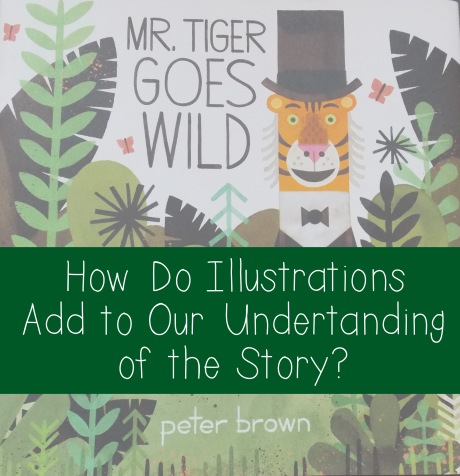Learning Goal: I can explain how illustrations add to the text in a story.
Key Questions:
What clues do the illustrations give about the characters?
What clues do the illustrations give about the setting?
What clues do the illustrations give about the plot?
Can you make predictions based on the illustrations?
FYI, these are the ELA Common Core Standards for Reading: Literature that this lesson meets:
1st Grade: RL 1.7 Use illustrations and details in a story to describe its characters, setting, or events.
2nd Grade: RL 2.7 Use information gained from the illustrations and words in a print or digital text to demonstrate understanding of its characters, setting, or plot.
3rd Grade: RL 3.7 Explain how specific aspects of a text’s illustrations contribute to what is conveyed by the words in a story (e.g., create mood, emphasize aspects of a character or setting).
We started by talking about our learning goal
{I can explain how illustrations add to what is written in a story}.
QUESTION: What clues can we find to help us understand the CHARACTERS, especially Mr. Tiger?Student responses included . . .
- Mr. Tiger has his eyes open and everyone else has them closed.
- The colors are dull except for Mr. Tiger.
- Everyone looks posh.
- Most of the animals are herbivores (I was so delighted with this observation by several of my students!). Mr. Tiger is different because he is a carnivore. Maybe this makes him more wild.
QUESTION: What clues can we find to help us understand the SETTING?
We looked at many pictures throughout the book, and made the following observations:
- He lives in a town or city.
- It is very dull colored and boring at the beginning.
- Guesses as to which city it might be included: New York City, Paris, and London. The kids guessed these cities mostly because of the pigeons. :)
QUESTION: What clues can we find to help us understand the PLOT?
The previous page says that Mr. Tiger has a wild idea . . . and then we turn to the picture of Mr. Tiger walking on all fours. No words. Just an illustration showing us what his wild idea was. I read it once without showing the picture (the kids agreed that there was missing information) and then again, this time showing them all the pictures. They understood so much more! (Just the learning moment I was looking for! ZING!)
Then we compared these two illustrations: one of Tiger being wild in the city and one of Tiger being wild in the wilderness. How are they the same? How are they different?
Reading and talking about this book was a BLAST! The children were riveted. Success! Thanks to Peter Brown and Mr. Tiger.
What kinds of questions do you ask during read aloud?








No comments:
Post a Comment